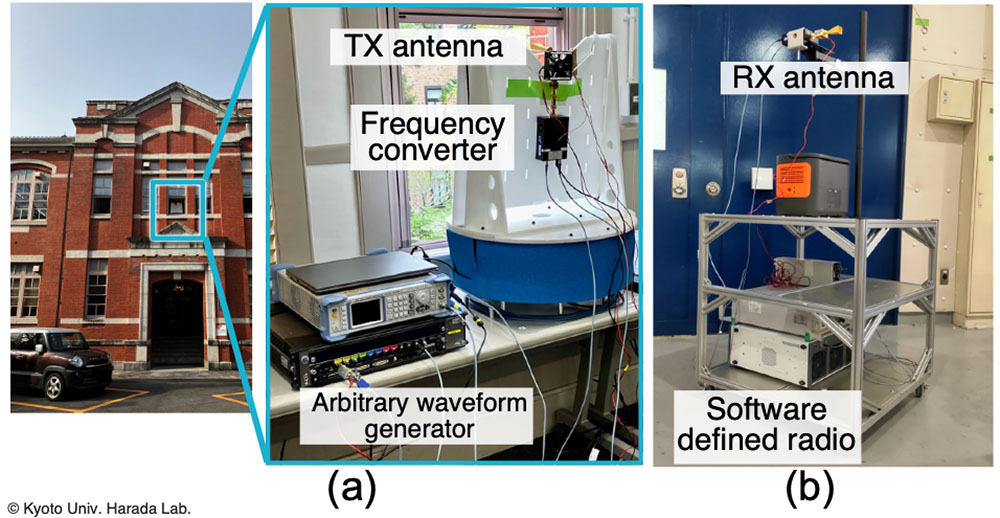






[Home] » [Press Release]
Development of Sub-THz Wideband Mobile Transmission Testbed for 6G and Successful Basic Transmission of Vehicle-Oriented Communication Systems
|
A research group led by Professor Hiroshi Harada and Assistant Professor Yusuke Koda at the Graduate School of Informatics, Kyoto University, has developed a wideband mobile transmission testbed using software-defined radio technology in the sub-terahertz band (100 GHz) for future 6G systems. In field trials conducted on a roadway approximately 200 meters long from an intersection, the group successfully achieved wideband mobile transmission with a channel bandwidth of 920 MHz—more than twice the maximum 5G channel bandwidth in Japan (400 MHz)—while adhering to the 5G-standardized transmission formats with the data rate of 1.7 Gbit/s. This achievement is expected to accelerate research and development for building ultra-high-speed wireless communication infrastructure capable of rapidly transmitting vehicle-related perception data, such as stationary camera footage at intersections, thereby contributing to a safer traffic society.
|

|
1. Background
The fifth generation (5G) mobile communication system, already in commercial use, is characterized by “high speed and large capacity,” “low latency,” and “massive connectivity.” The 5G mobile communication system is increasingly expected to evolve into a vital infrastructure not only for personal users but also for supporting industries and societal functions. This advancement requires the availability of broader frequency resources. Effective utilization of currently allocated 5G frequency bands—such as the sub-6 GHz band1 and the millimeter-wave band2 (e.g., 28 GHz)—is therefore critical. However, as 5G continues to proliferate and technology advances, even these bands may become congested in the future, making it necessary to explore new spectrum resources for the sixth generation (6G) mobile communication systems.
One promising candidate is the sub-terahertz (sub-THz) band, ranging from 100 to 300 GHz (see Fig. 2). This band offers significantly wider bandwidths than those available in the current 5G systems, making it a strong candidate for achieving ultra-high-speed wireless communications, such as for high-resolution video transmission.

|
However, sub-THz waves exhibit strong directivity and are significantly attenuated in non-line-of-sight environments, leading to severe degradation in communication quality. In response, several research efforts have focused on developing mobile communication systems using sub-THz waves for vehicular lanes, where line-of-sight can be more easily maintained. These systems aim to support safe and secure transportation by enabling high-resolution transmission of vehicle-related recognition data, such as overhead intersection imagery.
Despite these efforts, existing demonstrations involve transmission of only non-5G-compliant modulated signals or employ 5G-compliant waveforms within narrow bandwidths that do not exceed those currently assigned in the Sub-6 GHz range. Toward 6G, there is an urgent demand for investigating transmission characteristics—conforming to 5G standards but exceeding the current maximum 5G bandwidth (400 MHz)—in mobile environments using the sub-THz band. This will help to obtain insights into coverage areas and other key performance indicators.
Currently, within the 3rd Generation Partnership Project (3GPP)—the standardization body for 5G—there is a pathway to extend the maximum bandwidth by increasing the subcarrier spacing of the orthogonal frequency division multiple access (OFDMA) scheme3 from the current 120 kHz to 960 kHz. This technique enables the maximum bandwidth to expand from 400 MHz to 920 MHz. However, to realize this in practice, it is essential to develop receiver systems capable of receiving such a wide bandwidth signal appropriately and operating under sub-THz mobile environments. Consequently, the development of a well-designed testbed has been a pivotal challenge for exploring the sub-THz band towards 6G.
2. Research Results
A transmission testbed has been developed using software-defined radio (SDR) technology to enable the transmission of wideband signals in the sub-THz band, which exceed the currently allocated 5G channel bandwidths in Japan, while still conforming to the 5G physical layer signal format standardized by the 3GPP (see Fig. 1). This testbed has the following key features:
- Capable of transmitting 5G physical layer signals based on OFDMA in the sub-THz band (105 GHz), in compliance with the 5G standard.
- By increasing the subcarrier spacing of the OFDMA system—the minimum frequency unit that composes the waveform—from the current 120 kHz to 960 kHz, the maximum bandwidth is expanded from the current 400 MHz to more than double (920 MHz), achieving a transmission rate of 1.7 Gbit/s.
- Along with this wideband transmission capability on the transmitter (TX) side, a receiver (RX) was also developed using SDR technology. This receiver includes signal processing functions to synchronize and successfully receive signals under mobile conditions in the sub-THz band.
Using this testbed, a fundamental transmission experiment was conducted in an outdoor road environment including an intersection. Successful reception of the wideband transmission signal in the sub-THz band was achieved throughout the entire 200-meter stretch of roadway extending from the intersection (see Fig. 3(a)).

|
In the transmission experiments, the following two main evaluations were conducted:
- The TX was installed at a height of approximately 6 m inside a building facing the target intersection and roadway, and the TX beam was directed toward the center of the intersection (see Fig. 3(b), TX beam aiming point 1). The RX, shown in Fig. 1(b) and mounted on a mobile cart, was then moved within a range of approximately 100 m from the center of the intersection to record the received signals. The height of the RX antenna was set at 1.6 m.
- In the same TX installation location, the TX beam was directed toward a point approximately 100 m away from the center of the intersection (see Fig. 3(b), TX beam aiming point 2). The RX was moved within a range of approximately 200 meters from the intersection center to evaluate transmission characteristics.
The parameters for the transmission tests are summarized in Fig. 3(c). Both the TX and RX antennas were standard horn antennas with a gain of 25 dBi. In both experiments, the RX antenna was always oriented horizontally toward the intersection. The TX beam direction remained fixed and was not adjusted to follow the moving RX.
Fig. 4 presents the transmission characteristics at various waypoints along the RX trajectory. The block error rate (BLER) of the 5G signal is used as the evaluation metric for transmission performance. A BLER threshold of 0.1 was set as the criterion, with values below this threshold considered as successful transmission.

|
According to Fig. 4(a), when the TX beam was directed toward the center of the intersection, the BLER remained below 0.01 within approximately 50 m along the roadway, including the TX beam aiming point. According to Fig. 4(b), when the TX beam was directed to a point 100 m away from the intersection center, successful transmission was achieved over a range of approximately 200 m from the center of the intersection, excluding the immediate vicinity of the center of the intersection.
These results indicate that communication is feasible not only at the exact beam aiming point but also across a wide surrounding area. This is attributed to the nature of the beamforming radiation, which gradually spreads spatially as the propagation distance increases. Based on these findings, it was confirmed that the entire target roadway area can be covered without requiring precise beam tracking of the moving RX—by appropriately switching between two TX beam patterns: one directed at the intersection center and the other aimed further down the road.
3. Impact and Future Plans
The results using the developed transmission testbed demonstrated that in a road environment, wideband 5G signal transmission in the sub-THz band—exceeding the currently allocated 5G channel bandwidth—is feasible over a range of 200 m when the RX is properly designed. This was achieved without the need for the TX beam to precisely track the movement of the RX.
This outcome is expected to accelerate research and development toward building ultra-high-speed wireless communication infrastructure that enables the rapid transmission of vehicle-related perception data—such as stationary camera footage at intersections—within mobile communication environments. Such infrastructure would contribute to the realization of a safer and more secure transportation society.
Furthermore, the results are expected to provide valuable reference data for future industrial deployment when considering the coverage area of sub-THz vehicle communication systems. These research findings are scheduled to be presented at the 2025 Society Conference of the Institute of Electronics, Information and Communication Engineers (IEICE).
4. Research projects
A part of this research was conducted as part of a contract research project (JPJ010017C07501) sponsored by the National Institute of Information and Communications Technology (NICT).
Terminologies
» 1. sub-6 GHz band:
The frequency band that lies lower than 6 GHz. Generally, in Japan, the sub-6 GHz band is referred to as the band of 3.6–4.1 GHz and 4.5–4.9 GHz, which were additionally allocated for the 5G communication systems.
» 2. Millimeter wave band:
The frequency band ranging from 30 GHz to 300 GHz by definition. Additionally, the 28 GHz band, which is widely allocated for the 5G communication systems, is also referred to as a part of the millimeter wave band. However, it should be noted that the band of 100 GHz–300 GHz inside the millimeter wave band is not explored for commercial use, and this band is particularly referred to as the “sub-THz band” to distinguish it from the 5G millimeter wave band.
» 3. OFDMA (Orthogonal Frequency Division Multiple Access)
An extension of orthogonal frequency division multiplexing (OFDM), which transmits data in parallel by dividing it into orthogonal frequency subcarriers. OFDMA allows multiple wireless nodes to simultaneously communicate without mutual interference by assigning different subcarriers to each node. OFDMA was adopted for downlink communication in the fourth-generation mobile communication system, and is now used for both uplink and downlink communication in the 5G.
|
Contact Information |